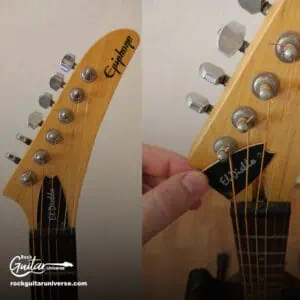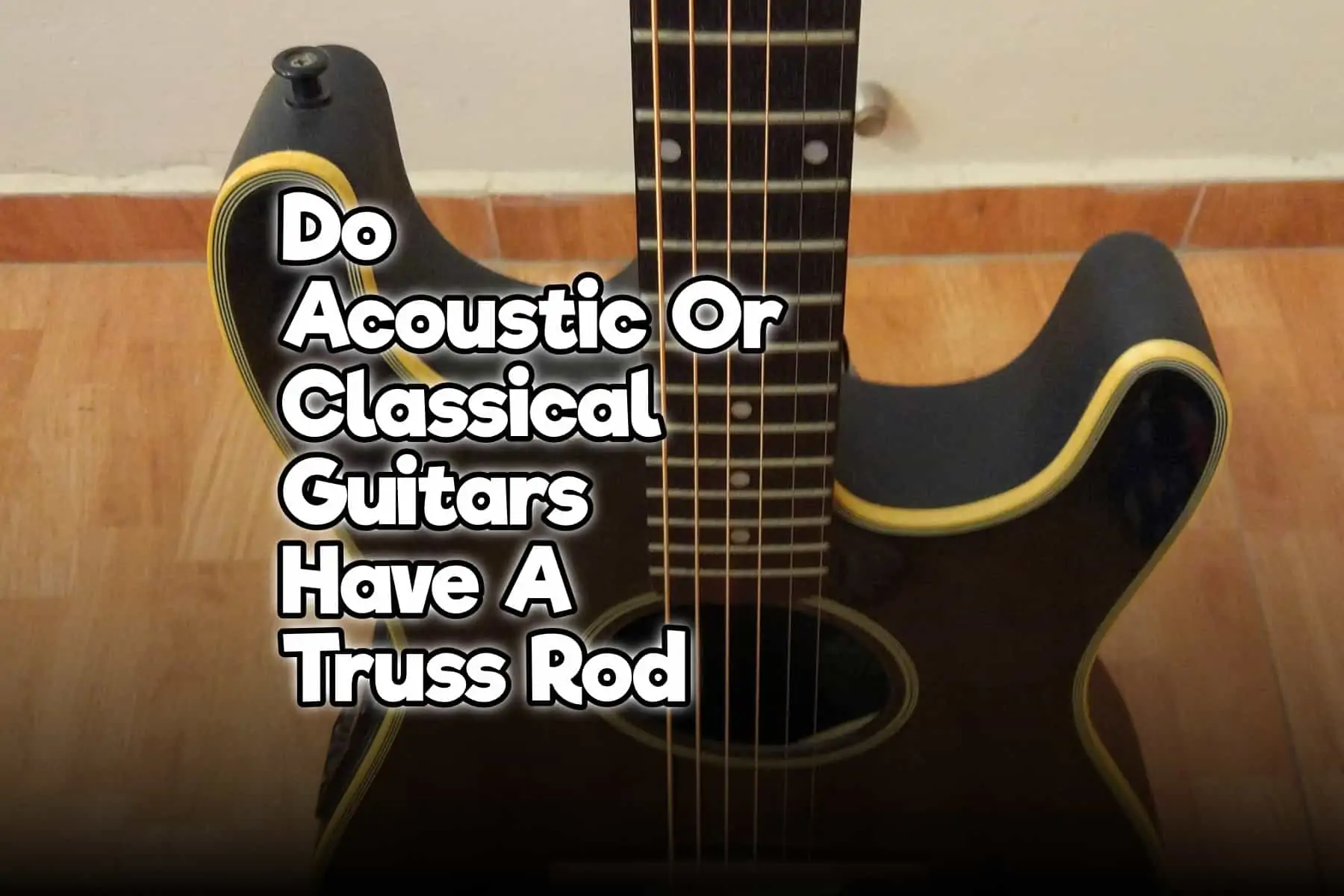People are wanting to know if acoustic or classical guitars have a truss rod. But what exactly is a truss rod? When you put on strings on the guitar, they create tension since and it is not something that should be ignored. The truss rod serves as a counter tension and it gives additional support to the neck.
So, do acoustic or classical guitars have truss rod? In short, acoustics usually do but classical usually don’t. Usually, all guitars with metal strings will have a truss rod, since the tension placed on the neck is much higher. Classical guitars usually use nylon strings, therefore there will be no reason for the truss rod. On the other hand, acoustic guitars with steel strings will have a lot of tension on the neck and they will have a truss rod inside the neck.
Of course, there are variations and so many questions that beginners would love to know. A truss rod is something that most guitars have and it is a rather important part of the guitar. However, improper care or adjusting, it could damage the guitar permanently.
How Do I Know If My Guitar Has A Truss Rod

So, first things first. One of the ways you can discover if your guitar has a truss rod or not is to search for the hole. Since the truss rod can be adjusted, there must be a way to access it. Guitars will usually have truss rod access on the headstock or inside the guitar, so this will be a place to look. Check the headstock of the guitar and if there is a hole where you can see a hex socket, congratulations! You’ve found the truss rod. Sometimes, manufacturers will put a plastic plate to cover the hole with the model name of the guitar, and if there is such a thing on the headstock, you should know that the truss rod is probably underneath.
The other option you should check is on the other side of the body. Since most acoustic guitars have a glued neck, the only way you can check it is to look at the soundhole. Sometimes, they will place the hex socket on that side, and it will be visible through the soundhole. If neither of these options works, there is a chance that your guitar is without a truss rod.
All electric guitars and almost every steel-string acoustic will have a truss rod. Since nylon strings create a lot less tension, they don’t always have a truss rod in the neck. However, there are many classical guitars with truss rod as well.
Why Do Guitars Have Truss Rod
When you put the strings on a guitar, you will have to tune them. One end will be fixed on a bridge, and the other will go on the tuning machines. Before you start tuning the guitar, there will be no issues whatsoever. But when you start tuning, you will tighten each of the strings until you reach the tuning you use. Each of the strings is under tension when the guitar is tuned, and this tension can be rather high. Since the guitar’s neck is made of wood, to avoid warping or bending of the neck, the truss rod is placed inside the neck or underneath the fretboard.
The truss rod is a steel bar that’s used to create a counter tension and stabilize the neck. While some can’t be adjusted, most modern guitars have an adjustable truss rod. This way, even if the guitar’s neck goes out of shape, you can easily counter that with adjustments to the truss rod. The other thing that can have a major impact on the shape of the neck is temperature and humidity. Since wood is prone to bend due to atmospheric changes, the truss rod can help the neck stay straight and as a result, the guitar will be playable. Usually, the materials used for creating the truss rod are steel and graphite, but it is possible to use other materials as well.
Another advantage of guitars with truss rod is that the manufacturers can use cheaper materials for the neck since there won’t be any need to use the best possible wood.
How Do I Know If My Truss Rod Needs Adjustment
If your guitar is new, there is a chance that you won’t need to adjust the truss rod at all. Usually, the guitars are pre-set at the store, and everything is perfectly set up. However, if your guitar is older and used, then it might need additional adjustment.
One of the possible signs that the truss rod needs adjustment is buzzing. If there are frets that buzz while you play them, this might be the problem. However, you shouldn’t just jump on fixing the truss rod since frets could be an issue as well. The buzzing of the strings is a bad sign, but it can point to several different issues as well.
Furthermore, be sure to know the tuning of the guitar. If the guitar tuning is set too low, it can cause the neck to over-bend. Most guitars are played in standard tuning, and if there is still buzzing that’s not related to frets or the nut, then the problem might be in the truss rod.
One of the first things you should do is check the neck. This is something that you can do easily since all you need to do is look down the neck. Take your guitar by the body and look down the strings to see if the neck is straight or not. Try avoiding holding the guitar by its headstock since you can put additional pressure on the neck.
Naturally, this is not the most accurate way to check the straightness of the neck, and it would be recommended to use appropriate tools to check it, something like a ruler. This will give you a more accurate picture of the shape of your neck. The other thing that people wonder is if their action is too high. The answer to this is not really accurate. Some people love higher action, and people who love lower. You should find the one that suits you the best and set your guitar accordingly. Most guitars will give you the option of adjusting the action, and you won’t have to buy a high-end guitar to set it up as you like the most.
When you finish checking the neck of the guitar, you will be able to see if the neck is straight, bowed, or if there are any irregularities. The tension on the guitar should be balanced. Depending on the string gauge you use, you would need to adjust the truss rod differently. For lighter strings, you will have less tension on the neck, and for heavier, there will be more. Whatever you choose, the truss rod should balance it and create a counter tension.
Should Neck Be Perfectly Straight
Many players believe that the neck of the guitar should be perfectly straight like an arrow. However, this is not always the case. Similar to most things when it comes to customization is that there are people who love it one way or the other. While there is no correct answer, one thing is certain – the neck shouldn’t be twisted, and it should be straight along the frets.
Some players love when the neck is a bit convex and others love it concave. Naturally, there are ones that love the neck perfectly straight. If the neck of the guitar is concaved or dipping, you can change it by tightening the truss rod in the neck and resisting the tension of the strings. On the other hand, if it is convexed or arching, you should loosen the truss rod if you wish to correct it. The tension of the strings can be as high as 200 pounds or around 90 kilograms.
We should also mention that there is a term called guitar neck relief. The term is used to describe the slight bow that is intentionally created on the guitar’s neck. By adding this bow, we create a distance between the fretboard and the strings allowing them to vibrate freely without touching the frets, to avoid buzzing. However, if the relief is too big, the strings will be too far away from the neck and the guitar will be a lot more difficult to play and rather uncomfortable.
While it might sound similar to changing the action, it is different since we don’t change the distance of the strings, but the shape of the neck.
How To Adjust The Truss Rod On A Guitar
We already mentioned that there is a hex socket located either on the headstock or at the end of the neck. When you locate the socket, you will need an appropriate Allen’s wrench or hex key. The reason why we mention that you need appropriate is if you damage a socket, you won’t be able to adjust the truss rod and you will have to replace the whole thing. To avoid this, be sure that you find the fitting hex key.
When you find it, assuming that you find out if the neck needs adjustment, you will proceed to “fix” the truss rod.
There are two options you’ll have when adjusting the truss rod. You will either need to tighten it, or to loosen it. There is no third option, other than doing nothing if the neck is in perfect shape. Furthermore, whatever the situation may be, you shouldn’t be scared and you won’t damage the guitar as long as you follow the steps and don’t overdo it.
One of the important things you need to know is that you should never turn the hex key too much. You should start with small turns and check the situation after each of the adjustments. Start by turning it around one-eighth of the turn. Usually, there won’t be a need for anything more than one-quarter of the turn.
Take the guitar, and place it in the playing position and not on the back. Measure the distance of the strings and start adjusting. Tightening the nut will effectively shorten the truss rod, therefore your neck will be pulled into a back bow. The famous “righty-tighty, lefty-loosey” will apply here as well. So if you want to create more relief and increase the distance between the fretboard and the strings, you will need to tighten the truss rod, turn it to the right to increase the action.
On the other hand, if there is already too much distance, and you want to lower the pressure and the height, you will loosen the nut, turn it to the left to lower the action. By loosening the nut, you will increase the length of the truss rod, and straighten the neck if it was already bowed. It is such an easy thing to do, and you will be able to finish it in no time. Just remember that you shouldn’t do either of these actions too much since it might cause the truss rod to break which will make the guitar unplayable.
Should You Adjust Truss Rod With Or Without Strings
If you remove the strings while adjusting the truss rod, you won’t have a realistic representation of the neck’s shape. Since there is no tension on the neck when strings are removed, you won’t be able to adjust it accordingly. We already mentioned that the truss rod creates a contra tension and by removing the strings, you won’t even know the shape of your neck.
Plus depending on the string gauge, you will need to know the exact conditions that your guitar will be exposed to. This is why you need to do this with strings on. By placing all of the strings, and tuning them to pitch, you will create accurate work conditions and the tension that the guitar’s neck will be exposed to. On the other hand, there are guitars, especially electric ones, where you won’t have the access to the truss rod unless you remove the strings. So, saying that one way is good and the other is bad would be incorrect.
However, some people prefer adjusting the truss rod without strings. One of the positives of this approach is that there won’t be much tension, and it will be a lot safer for the guitar itself. Whichever option you choose, you should always keep in mind that you should turn the nut in small increments, and by small we mean very small. Tightening the truss rod too much can cause it to snap, while loosening can cause it to wrap. Whatever you do, keep in mind that you should take it slowly.
Final Word
Adjusting the truss rod is not difficult, but if you feel scared, or you fear that you might do something wrong, you can always take your guitar to a service where they will be able to do it in no time. Acoustic guitars can be a lot more difficult to set up, and sometimes can cause problems even if you have a lot of experience doing it.
It is also worth mentioning that there are guitars that have more than one truss rod, and while it is more common for basses, it is still something we should mention. Bass guitars have even thicker strings so the tension can be quite high. By adding the additional truss rod, the manufacturer ensures that the tension of the strings remains balanced. If your guitar is one of those with two truss rods, you should know that there is a possibility to twist the neck by adjusting truss rods unevenly.
Finally, there are guitars out there with not-so-great designs, where the truss rod is not easily approachable. For some models, you will even need to remove the neck to be able to approach that hex socket. Naturally, you will need to loosen the strings if you want to achieve that. In the end, it is important to remember that you are not obligated to do this and that you can always take the guitar to the professional. Many players, especially beginners, would rather avoid messing with the truss rod, and there is no shame in that. If you damage the rod, you will cause major damage to the guitar and it is not something that can be fixed as easily as a broken string can.
If you found this article useful, you may want to save this pin below to your Guitar board.

Recent Posts
Some guitarists insist on buying an expensive amplifier with their electric guitar. They assume that this is a must for every type of guitarist out there. However, in some situations, this isn’t...
Top 50 Free Realistic Guitar VST Plugins With Sound Examples
As technology has rapidly advanced in the recent decade, computers are stealing more and more roles from physical musical instruments and accessories. Nowadays, you do not need expensive amps,...

